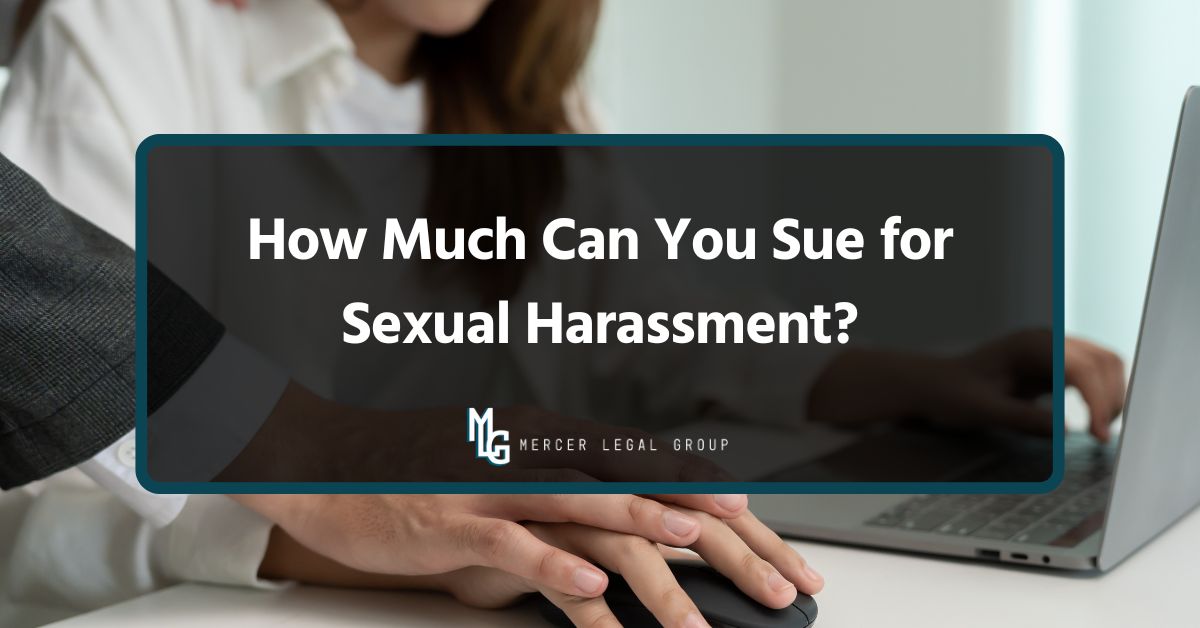Sexual harassment cases and claims can result in significant financial compensation, depending on the severity of the misconduct and its impact on the victim. If you’re wondering how much you can sue for sexual harassment, settlements and verdicts often range from tens of thousands to several hundred thousand dollars, with some cases reaching into the millions. The exact amount depends on factors such as lost wages, emotional distress, and whether punitive damages are awarded.
At Mercer Legal Group, our experienced sexual harassment attorneys have a proven track record of success in employment law. We’ve helped countless clients navigate harassment and retaliation claims, maximizing recovery while protecting their rights. Known for our trusted advocacy and thorough case preparation, we build the strongest possible claims on behalf of our clients. Contact us today for a free, confidential consultation and let us fight for the justice and compensation you deserve.
In this blog, we are going to break down the factors that determine how much you can sue for in a sexual harassment case, including typical settlement amounts, possible damages, and what can influence the value of a case.
What Counts as Sexual Harassment?

Sexual harassment in the workplace generally refers to behavior of a sexual nature that is unwelcome and creates an intimidating, offensive, or hostile work environment. It can include actions, comments, or conduct that interfere with an employee’s ability to work comfortably and safely. Both federal and state employment laws recognize sexual harassment as a form of discrimination.
Examples of sexual harassment include various forms of verbal, physical, and non-verbal conduct. Verbal conduct may include inappropriate jokes, comments, or repeated unwelcome sexual advances. Physical conduct can involve unwanted touching, groping, or blocking a person’s movement. Non-verbal behavior might include leering, displaying offensive images, or sending suggestive messages. Even if the harassment does not involve physical contact, persistent unwelcome actions can still qualify.
There are two main types of sexual harassment claims: hostile work environment and quid pro quo harassment. A hostile work environment occurs when unwelcome conduct is so severe or pervasive that it significantly affects an employee’s ability to perform their job effectively. On the other hand, quid pro quo harassment happens when a supervisor or person in authority demands sexual favors in exchange for job benefits, promotions, or protection from negative consequences.
Can You Sue for Sexual Harassment?
Indeed, you can sue for sexual harassment under federal and state laws that protect employees from discrimination and workplace misconduct. Title VII of the Civil Rights Act prohibits sexual harassment in the workplace, and many states provide additional protections that may expand your rights or extend filing deadlines. These laws ensure employees have legal recourse when faced with workplace harassment that interferes with their ability to work safely.
A lawsuit may be appropriate if filing a complaint with the EEOC or a state agency does not resolve the issue or if the workplace harassment is severe and ongoing. In most cases, you must first file an EEOC charge before suing, but once you receive a “right-to-sue” letter, you can take your case to court. This process helps filter and investigate claims while still giving victims the ability to pursue justice through litigation if needed.
When suing for sexual harassment, liability may fall on the harasser, the employer, or the company as a whole. Employers can be held responsible for workplace harassment cases if they fail to prevent or address it after being notified, while individual harassers may also face personal liability in some jurisdictions. By taking harassment claims seriously, this accountability structure aims to safeguard employees and foster a respectful workplace.
How Much Can You Sue for Sexual Harassment?

The amount you can sue for sexual harassment varies widely, but average settlements often range from tens of thousands to several hundred thousand dollars. Many sexual harassment cases resolve in the $30,000 to $100,000 range, while others involving severe harm or strong evidence can result in much higher awards. These amounts are meant to cover wage loss, emotional distress, medical costs, and sometimes punitive damages.
In high-profile cases, verdicts and sexual harassment settlements have reached into the millions of dollars, reflecting the seriousness of the misconduct and its long-term impact on victims. These larger awards often come from cases with extensive evidence, significant emotional or physical harm, or misconduct by individuals in positions of power. They serve as reminders of how seriously courts and juries take proven sexual harassment claims.
However, outcomes vary based on several factors, including the strength of evidence presented, whether the harassment created a hostile work environment or involved quid pro quo demands, and the financial resources of the employer. Since no two cases are alike, the potential value of a lawsuit depends on the unique circumstances surrounding each claim.
Are There Limits on Sexual Harassment Damages?
Under federal law, Title VII of the Civil Rights Act places caps on certain types of damages in sexual harassment cases, depending on the size of the employer. These caps range from $50,000 for small employers to $300,000 for the largest employers, and they apply to compensatory and punitive damages, such as emotional discomfort or punishment for misconduct.
However, state laws may allow higher compensation or even remove limits altogether, giving victims the chance to recover more than the federal cap permits. Some states have broader protections or do not impose caps on damages, which can significantly affect the outcome of a case depending on where the lawsuit is filed.
It’s also important to note that there is no cap on lost wages or certain economic damages like back pay awards, front pay, or lost benefits. This means victims can still recover the full amount of losses caused by the workplace harassment, regardless of federal law limits on non-economic damages.
Types of Damages You Can Recover
In a sexual harassment case, victims may recover economic damages to compensate for measurable financial losses. These include lost wages from missed work, lost promotions or career opportunities, and medical bills related to therapy, mental health issues, counseling, or other treatment needed due to workplace harassment. Economic damages are typically straightforward to calculate and backed by employment or medical records.
Victims can also seek non-economic damages, which cover the emotional and psychological harm caused by harassment. This may include compensation for pain, suffering, stress, humiliation, or damage to reputation. Since these losses are harder to quantify, courts often consider testimony, medical evaluations, and the overall impact on a victim’s quality of life.
In cases involving particularly severe or reckless misconduct, such as sexual abuse, courts may award punitive damages. These are not tied to the victim’s direct losses but are designed to punish the harasser or employer for egregious behavior and to deter similar conduct in the future. Punitive damages can significantly increase the overall value of a harassment case.
What Factors Affect Compensation?

Several factors influence how much compensation a victim of sexual harassment may receive, starting with the severity and duration of the harassment. A single inappropriate comment may not carry the same weight as ongoing, repeated misconduct that creates a hostile work environment. The longer and more severe the harassment, the greater the potential damages in both settlements and verdicts.
The emotional and psychological impact of workplace harassment is another major factor in determining compensation. Sexually harassed victims who experience mental anguish, anxiety, depression, post-traumatic stress, or a decline in overall mental health due to the harassment may be entitled to more compensation. Courts and juries often consider medical records, therapy costs, and expert testimony when evaluating these non-economic damages.
Career setbacks and lost wages can also significantly increase compensation. If harassment led to missed promotions, forced resignation, job loss, or reduced earning potential, victims may be awarded damages to cover both past and future financial losses. These economic impacts are often easier to calculate but can add up to a substantial portion of the overall award.
Finally, employer negligence or retaliation plays a crucial role in the outcome. If an employer ignored complaints, failed to take corrective action, or punished the victim for speaking up, the damages awarded may be much higher. In some cases, courts may also impose punitive damages to punish especially reckless or malicious conduct and deter future violations.
Legal Process for Filing a Sexual Harassment Lawsuit
Filing a sexual harassment lawsuit can feel overwhelming, but breaking it down into clear steps helps make the process easier to understand. The process of filing a sexual harassment lawsuit involves several key steps:
- File a charge with the EEOC or state agency – Most cases require this step before proceeding to court.
- Agency investigation or mediation – The agency may investigate, mediate, or issue a “right-to-sue” letter.
- Filing the lawsuit – Once you receive the letter, you can proceed with a lawsuit in state or federal court.
- Discovery and evidence gathering – Both sides exchange documents, witness statements, and other relevant information.
- Settlement negotiations or trial – Many cases resolve through settlement, but some proceed to trial for a verdict.
Throughout this process, documentation and evidence are crucial to proving your claim. Detailed records of incidents, written complaints, witness statements, and saved communications like emails or texts strengthen your case by showing a consistent pattern of harassment.
It’s also important to understand time limits for filing a charge and the applicable statutes of limitations. Generally, you must file a charge with the EEOC within 180 to 300 days of the harassment, depending on your state, and lawsuits must be filed within a specific period after receiving your right-to-sue letter. Missing these deadlines can jeopardize your ability to seek redress, making timely action essential.
How to Strengthen Your Sexual Harassment Case?
One of the most effective ways to strengthen your sexual harassment case is by documenting incidents and gathering evidence. Keep detailed records of dates, times, locations, people involved, and the nature of each incident. Save any supporting evidence, such as emails, texts, voicemails, or witness statements, as these can be critical in proving a pattern of misconduct.
It’s also important to report the harassment through the proper workplace channels, such as a supervisor, upper management, or human resources department, or according to your company’s policy. Making a formal complaint not only establishes a record of the behavior but also shows that you took reasonable steps to stop it, which can support your legal claim.
Before pursuing a lawsuit, most victims are required to file a charge with the Equal Employment Opportunity Commission (EEOC) or a relevant state agency. This step ensures your claim is formally reviewed and allows the agency to investigate or attempt resolution. Skipping this process could delay or even prevent your ability to sue later on.
Finally, hiring an experienced sexual harassment attorney is essential for building a strong case and navigating strict legal deadlines. Acting quickly matters, as sexual harassment claims are subject to a statute of limitations, meaning waiting too long could result in losing your right to pursue compensation. With professional guidance, you can protect your rights and maximize both the strength of your claim and your potential compensation.
Why Legal Representation Matters

Navigating a sexual harassment claim can be challenging because it involves complex federal and state employment laws, each with specific rules, deadlines, procedures, and filing fees. An experienced attorney helps ensure that your case is filed correctly, backed by strong evidence, and compliant with all legal requirements, so you do not risk losing your right to receive fair compensation.
Legal guidance also plays a critical role in negotiating for the maximum settlement or trial award, as lawyers understand how to calculate damages and present evidence effectively. In addition, they ensure that retaliation claims, such as workplace discrimination, demotion, firing, or harassment after reporting misconduct, are fully addressed, thereby protecting your rights and strengthening your overall case.
Pursue Justice in Sexual Harassment Cases
Sexual harassment is a form of employment discrimination, and victims have the legal right to hold harassers and negligent employers accountable while pursuing compensation for the harm they’ve suffered. As discussed in this blog, settlement amounts can range widely, with potential damages covering lost wages, emotional distress, and even punitive awards in cases of severe misconduct—often resulting in substantial financial recovery.
Since every case is different, the best way to determine the true value of your claim is to speak with an experienced sexual harassment lawyer. A lawyer can evaluate your situation, explain your options, and guide you through the legal procedure, giving you the strongest chance at justice and fair compensation.
Are you wondering what factors truly affect the value of a sexual harassment claim? At Mercer Legal Group, our experienced employment lawyers have decades of combined expertise and a proven record of securing substantial settlements and verdicts for clients in harassment and retaliation claims. Recognized for our trusted advocacy and thorough case evaluations, we carefully assess every detail that impacts compensation, from emotional distress to lost wages, to maximize recovery. Don’t wait; speak with a skilled sexual harassment lawyer at Mercer Legal Group today for a free consultation and get clarity on your options in under 30 minutes.
FAQ
If you’re considering legal action for sexual harassment, you probably have many questions about what to expect. Below are answers to some of the most common FAQs to help you understand your options and potential outcomes.
What Is the Average Harassment Settlement?
The average harassment settlement can range widely, often falling between $30,000 and $100,000, depending on the severity of the misconduct, evidence, and damages suffered. However, some cases may settle for much higher or lower amounts based on the specific circumstances.
How Much Money Can You Get From a Sexual Assault Lawsuit?
The amount of money sexual harassment cases settle for varies greatly, with settlements and verdicts often ranging from tens of thousands to several million dollars, depending on factors like medical costs, emotional trauma, and long-term impact. The exact amount will depend on the strength of the case and the extent of damages proven.
How to Calculate Harassment Damages?
Compensatory damages for harassment are typically calculated by considering economic losses (like lost wages or medical expenses) and non-economic losses (such as emotional distress, pain and suffering, or reputational harm). In some cases, punitive damages may also be awarded to punish especially egregious conduct.
What Makes a Strong Harassment Case?
A strong harassment case usually includes clear documentation such as emails, messages, witness statements, or reports that show a pattern of unwanted behavior. It’s also strengthened by evidence of tangible harm, like emotional distress, lost income, or negative effects on career opportunities.




